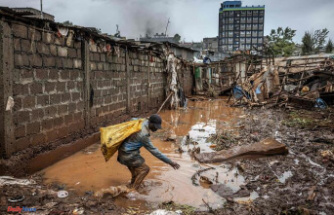The mass death of fish shocked people on both sides of the Oder. How can the river go on? First of all, he needs time, says aquatic ecologist Markus more. However, the catastrophe will possibly change the fauna of the river significantly.
For Markus more, it looks like a "complete reset of the entire fish fauna" on the Oder. The head of the Department of River Ecology at the Helmholtz Center observes the developments there with great concern. In an interview with ntv.de, he emphasizes that the mysterious death of fish is an "extraordinary catastrophe".
Low water and high temperatures repeatedly lead to the death of animals that live in the water. More still remembers the hot summers of 2018 and 2019. Fish died back then, too, especially in smaller bodies of water. But the fact that animals died on such a large scale in a river like the Oder "is very rare on this scale," emphasizes the aquatic ecologist.
In his estimation, one of the greatest environmental disasters in decades is taking place on the Oder. And it's not even clear what exactly triggered it. According to the researcher, a particularly dramatic cause would be a toxin that is not washed out and broken down, but is deposited in the river and continues to have an effect there. Because: "Once the poison is in the environment, we can't get it out." The mercury initially suspected to be behind the fish kill in the Oder is such a permanent poison. But more does not consider it to be the cause of the disaster - at least according to the current state of knowledge. Initial laboratory tests had not been able to find any increased mercury levels in the dead fish.
In any case, many experts assume that several factors are responsible for the fish kill. The entire ecosystem of the river is "stressed," says More. The water researcher attributes this to structural interventions, among other things: the Oder with its extensive floodplains is in comparatively good shape. Nevertheless, a once branched river landscape has been converted into a shipping lane. As a result, animals are cut off from possible retreat areas, the scientist explains.
The strong algae load in the Oder is also suspicious. This could further destabilize the ecosystem: Because algae cause a high level of oxygen pollution during the day, the oxygen is broken down again at night. These fluctuations caused problems for the river and its inhabitants. Algae production also influences the pH value of water bodies. The ecologist considers it quite possible that such factors play a role in the Oder. "But I don't assume that they alone have led to a fish kill on this scale." The basic pollution might have prepared the ground for the disaster - a pollutant could then make the camel overflow.
A potentially toxic alga by the name of Prymnesium parvum is currently being traded as the cause of the catastrophe. It is said to have spread rapidly in the Oder. More thinks this explanation is possible, but still has doubts: "We need evidence that the algae actually produce toxins and that their occurrence actually corresponds to the times and places of the fish die-off." However: Even the rapid growth of the algae is not a natural cause for more. Because the plant only occurs in brackish water and is dependent on high salt concentrations and nutrient input. And in fact, in the past few weeks, an unusually high level of salt pollution has been detected in the Oder.
No matter which pollutant is responsible: "We cannot completely clean the Oder," says more: "We have to hope that the toxin in the Baltic Sea can be diluted or broken down in the ecosystem." How quickly the river recovers does not depend solely on the type of poisoning anyway. In the eyes of the researcher, it is crucial for the resettlement of the Oder whether their natural refuges will function as such. Whether fish and other aquatic life in tributaries and flood plains could hide from the threat that the main stream posed to them, at least for a while. There is at least hope for more: the lower Oder valley in particular offers animals refuge.
The scientist investigates how human life pollutes running water in general. In view of the catastrophe on the Oder, however, he considers it particularly urgent to protect the ecosystem as much as possible. In his opinion, the damage done can only be limited selectively, for example by removing fish carcasses. It might be helpful to restrict fishermen and anglers for a while. But: "The best thing you can do is often in the past," says the water researcher: "Because intact ecosystems are better able to cope with such disasters." It is now a matter of hoping for the natural regeneration of the Oder and promoting it wherever possible.
It will probably take years for this recovery phase to be fully completed: if animals were able to hide in side arms and continue to find food in the main stream, "we will see fish in the Oder again relatively quickly," More estimates. However, it will take a long time before the Oder resembles the body of water it was before the catastrophe.
But even if the Oder is as lively again in a few years as it was before the fish died out in the summer of 2022 - life in the river may be completely different. Another tries to describe this with the image of the changing community: He thinks it is possible that some fish in the Oder no longer reach their original stocks and thus make room for others. In the eyes of the scientist, invasive species could benefit from such a new beginning, especially in large bodies of water like the Oder, because they are already widespread there anyway. In addition to fish, this also applies to aquatic invertebrates such as worms or snails.
Even if there is little that can be done for the Oder in the short term: In principle, more believes it makes a lot of sense to keep rivers fit for the next load. "The resilience of an ecosystem depends on its condition," says the aquatic ecologist. "There's a lot we can do." Connection to floodplains, more protected habitats for animals, less input of nutrients and pollutants - there are definitely ways to reduce stress factors to support the recovery of a river. According to more, this also makes sense to prevent the dominance of invasive species, which particularly like to establish themselves in disturbed habitats.
That worked in Switzerland. After a natural disaster towards the end of the last century, meticulous attention is paid to the water quality there. A fire in the Sandoz chemical company's plant in 1986 led to firefighting efforts, during which tons of pesticides and insecticides found their way into the Rhine with the water. The poisonous wave had reached the German capital of Bonn within a week, killing masses of fish along the way.
The Sandoz shock has led to better surveillance chains, says more. Close-meshed early warning systems have been installed on the Rhine. The river has recovered, salmon are now swimming there again - and in Basel people drift along the Rhine in summer. The professor sighs: "Unfortunately, the international early warning system on the Oder has not yet worked that well."












